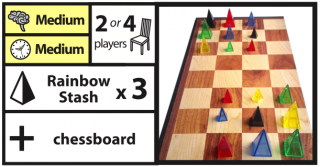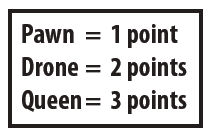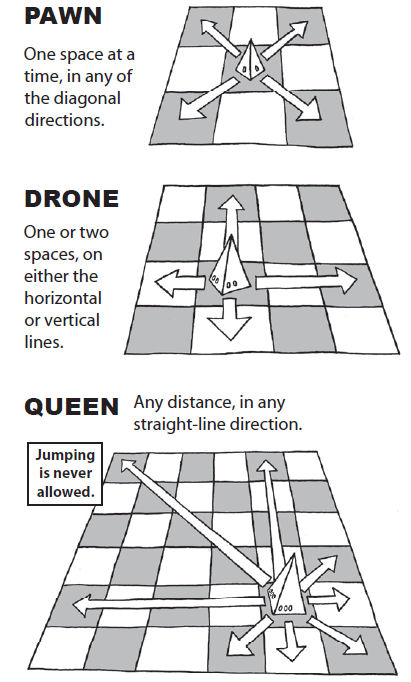
How to Play Martian Chess
Designed by Andy Looney
 Introduction: In Martian Chess, color means nothing. Instead, location determines which pieces you may move. As in Chess, each type of piece has its own way of moving, and you capture by entering an opponent piece’s square. However, you can move only the pieces sitting in your sixteen-square section of the board, and you can only attack pieces in other zones.Thus, a piece changes ownership after it attacks. The game ends when a player has no pieces left in their quadrant.
Introduction: In Martian Chess, color means nothing. Instead, location determines which pieces you may move. As in Chess, each type of piece has its own way of moving, and you capture by entering an opponent piece’s square. However, you can move only the pieces sitting in your sixteen-square section of the board, and you can only attack pieces in other zones.Thus, a piece changes ownership after it attacks. The game ends when a player has no pieces left in their quadrant.
Equipment: 6 Trios (for 2 players) or 12 Trios (for 4) of any color, Chessboard
Number of Players: 2 or 4
 Other groups sizes: This game can also be played with 3, 5, or 6 players; however, you will need special wedge-shaped gameboards. Find them here:
Other groups sizes: This game can also be played with 3, 5, or 6 players; however, you will need special wedge-shaped gameboards. Find them here:
http://www.ee0r.com/tri-chess/
Setup: Each player starts by settingup nine pyramids, three of each size, in the corner of their quadrant of the board, as shown here.


Randomize Colors: Since color has no meaning, each player should select a variety of colors to start out with, in order to make it easier todisregard the color of the pyramids.
Binary Setup: For the two player game, a half-sized board is used. (The other half of the chessboard should be folded away or covered up.) The pieces are then set up in opposing corners as shown.


Goal: Get the most points. (“Checkmate” is an Earthly concept; the term has no meaning here.)
Scoring: Each piece you capture is worth its pip count in points; the winner is whoever has the highest score.
Who Starts: Place a Queen for each player into an opaque bag or hat, with just one being red (or orange). Each player draws a piece, and whoever gets the red Queen goes first.
Turn Options: On your turn, move one of the pieces in your quadrant as follows:

Ownership: You control ALL and ONLY the pieces currently in your quadrant of the board. After you move your piece into another player’s quadrant, it stopsbeing your piece.
Canals: It’s helpful to imagine that the quadrants are divided by small canals.
Capturing: When your piece moves into a space occupied by an opponent’s piece, remove their piece from the board and keep it for scoring.
Field Promotions: If you have no Queens, you can create one by moving a Drone into a Pawn’s space (or vice versa) and merging them. Similarly, if you control no Drones, you can make one by merging two of your Pawns.
No Undo With Two: In a 2-player game, your opponent may not “reject” your move; if one player moves a piece across the canal, the other can’t move it back to the same square it came from.
Game Over: The game ends as soon as one quadrant is totally empty. This means if you have only one piece left, you can force the end of the game by moving your last piece across a canal. Then, everyone totals up their captured pieces, and the high score wins!
Breaking Ties: If the game ends in a tie, the player who made the move that caused the tie is the winner. This includes the case in which a third player with a lower score can win by causing the game to end in a tie between 2 other players.
STRATEGY TIPS
Beware the Double Whammy: Whenever you capture a piece, make sure the piece you moved isn’t in a position where it can immediately capture one of your own remaining pieces (unless you’re happy enough making an exchange...).Remember the
Bottom Line: Keep in mind that the goal is points, not position. This is particularly vital in a four-player game, when two people can use the Double Whammy on each other to quickly trade pieces for points.
Run for the Border: If you’re ahead on points and low on pieces, try to end the game quickly by pushing your last few pieces across a canal.


